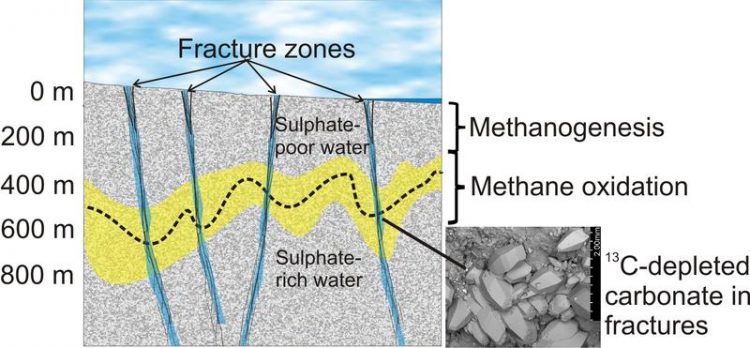Previously unknown sink for methane deep discovered deep in granitic rock

Schematic image of the preferential occurrence of methane oxidation at the transition to a deep sulphate-rich water.
The methane in the granite is consumed through microbe-mediated anaerobic oxidation, a process dominantly described from marine seabeds where it significantly mitigates the escape of methane to the atmosphere. However, the methane oxidation deep in the granite shows several intriguing differences compared to marine seabeds.
What makes the methane oxidation in the energy-poor fractured granite unique compared to other environments is the previously unseen magnitude of 13C-depletion in the carbonates precipitated during the methane oxidation.
The isotopic composition of co-genetic sulphide and specific biomarkers (e.g. fatty acids) preserved within the carbonates suggest presence of syntrophic consortia of methane oxidisers and sulphate-reducers.
Another unique feature in the fractured granite is that methane formed at shallow depth and oxidised at several hundred meters depth at the transition to a deep-seated sulphate-rich saline water.
This spatial distribution of methane and sulphate is completely opposite to what is observed during methane oxidation in near surface environments such as seabeds.
This previously unknown methane-trapping process of surficial methane at the transition to a deep sulphate-rich water can theoretically be widespread in the sparsely investigated deep terrestrial landscape. This process can thereby be of importance for the carbon cycling within the upper crust and for preventing methane to reach the atmosphere.
The results are presented in the article ”Extreme 13C-depletion of carbonates formed during oxidation of biogenic methane in fractured granite” in Nature Communications (open access).
Contact: Henrik Drake, henrik.drake@lnu.se
http://www.nature.com/ncomms/2015/150507/ncomms8020/abs/ncomms8020.html
Media Contact
All latest news from the category: Earth Sciences
Earth Sciences (also referred to as Geosciences), which deals with basic issues surrounding our planet, plays a vital role in the area of energy and raw materials supply.
Earth Sciences comprises subjects such as geology, geography, geological informatics, paleontology, mineralogy, petrography, crystallography, geophysics, geodesy, glaciology, cartography, photogrammetry, meteorology and seismology, early-warning systems, earthquake research and polar research.
Newest articles

A universal framework for spatial biology
SpatialData is a freely accessible tool to unify and integrate data from different omics technologies accounting for spatial information, which can provide holistic insights into health and disease. Biological processes…

How complex biological processes arise
A $20 million grant from the U.S. National Science Foundation (NSF) will support the establishment and operation of the National Synthesis Center for Emergence in the Molecular and Cellular Sciences (NCEMS) at…

Airborne single-photon lidar system achieves high-resolution 3D imaging
Compact, low-power system opens doors for photon-efficient drone and satellite-based environmental monitoring and mapping. Researchers have developed a compact and lightweight single-photon airborne lidar system that can acquire high-resolution 3D…





















